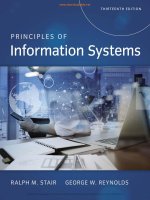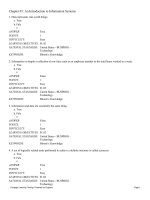Ebook Principles of information systems (13E): Part 1
Bạn đang xem bản rút gọn của tài liệu. Xem và tải ngay bản đầy đủ của tài liệu tại đây (18.01 MB, 317 trang )
www.downloadslide.net
Copyright 2018 Cengage Learning. All Rights Reserved. May not be copied, scanned, or duplicated, in whole or in part. WCN 02-200-203
www.downloadslide.net
Thirteenth Edition
Principles of
Information Systems
Ralph M. Stair
Professor Emeritus, Florida State University
George W. Reynolds
Instructor, Strayer University
Australia • Brazil • Mexico • Singapore • United Kingdom • United States
Copyright 2018 Cengage Learning. All Rights Reserved. May not be copied, scanned, or duplicated, in whole or in part. WCN 02-200-203
www.downloadslide.net
Principles of Information Systems,
Thirteenth Edition
Ralph M. Stair & George W. Reynolds
Vice President, General Manager, Science,
Technology and Math: Balraj Kalsi
© 2018, 2016 Cengage Learning
ALL RIGHTS RESERVED. No part of this work covered by the copyright herein
may be reproduced or distributed in any form or by any means, except as
permitted by U.S. copyright law, without the prior written permission of the
copyright owner.
Senior Product Director: Kathleen McMahon
Senior Product Team Manager: Joe Sabatino
Product Team Manager: Kristin McNary
Associate Product Manager: Kate Mason
Senior Director, Development: Julia Caballero
For product information and technology assistance, contact us at
Cengage Learning Customer & Sales Support, 1-800-354-9706
For permission to use material from this text or product,
submit all requests online at www.cengage.com/permissions
Further permissions questions can be emailed to
Content Development Manager: Leigh Hefferon
Associate Content Developer: Jonathan Gross
Senior Content Developer: Michelle Ruelos
Cannistraci
Art and Cover Direction, Production
Management, and Composition:
Lumina Datamatics, Inc.
Intellectual Property Analyst: Brittani Morgan
Project Manager: Kathy Kucharek
Manufacturing Planner: Ron Montgomery
Cover Image(s): everything possible/
Shutterstock.com
Library of Congress Control Number: 2016941569
ISBN: 978-1-305-97177-6
Cengage Learning
20 Channel Center Street
Boston, MA 02210
USA
Cengage Learning is a leading provider of customized learning solutions
with employees residing in nearly 40 different countries and sales in
more than 125 countries around the world. Find your local representative at
www.cengage.com
Cengage Learning products are represented in Canada by Nelson Education, Ltd.
To learn more about Cengage Learning Solutions, visit www.cengage.com
Purchase any of our products at your local college store or at our preferred
online store www.cengagebrain.com
Unless otherwise noted all items © Cengage Learning®
Printed at EPAC, Mexico, 11-16
Copyright 2018 Cengage Learning. All Rights Reserved. May not be copied, scanned, or duplicated, in whole or in part. WCN 02-200-203
www.downloadslide.net
For Lila and Leslie
— RM S
To my grandchildren: Michael, Jacob, Jared, Fievel,
Aubrey, Elijah, Abrielle, Sofia, Elliot, Serena, and Kendall
—G W R
Copyright 2018 Cengage Learning. All Rights Reserved. May not be copied, scanned, or duplicated, in whole or in part. WCN 02-200-203
www.downloadslide.net
Copyright 2018 Cengage Learning. All Rights Reserved. May not be copied, scanned, or duplicated, in whole or in part. WCN 02-200-203
www.downloadslide.net
Brief Contents
PART 1
Information Systems in Perspective
1
Chapter 1 An Introduction to Information Systems
2
Chapter 2 Information Systems in Organizations
PART 2
Information Technology Concepts
Chapter 3 Hardware and Mobile Devices
83
84
Chapter 4 Software and Mobile Applications
Chapter 5 Database Systems and Big Data
Chapter 6 Networks and Cloud Computing
PART 3
Business Information Systems
Chapter 7 Electronic and Mobile Commerce
Chapter 8 Enterprise Systems
44
136
192
238
295
296
344
Chapter 9 Business Intelligence and Analytics
382
Chapter 10 Knowledge Management and Specialized
Information Systems 408
PART 4
Planning, Acquiring, and Building Systems
Chapter 11 Strategic Planning and Project Management
Chapter 12 System Acquisition and Development
455
456
502
v
Copyright 2018 Cengage Learning. All Rights Reserved. May not be copied, scanned, or duplicated, in whole or in part. WCN 02-200-203
www.downloadslide.net
vi
BRIEF CONTENTS
PART 5
Information Systems in Business and Society
Chapter 13 Cybercrime and Information System Security
559
560
Chapter 14 Ethical, Legal, and Social Issues of Information
Systems 598
Glossary 636
Subject Index
Company Index
647
657
Copyright 2018 Cengage Learning. All Rights Reserved. May not be copied, scanned, or duplicated, in whole or in part. WCN 02-200-203
www.downloadslide.net
Contents
Preface
PART 1
1
xv
Information Systems in Perspective
1
An Introduction to Information Systems 2
Part 1: Information Systems in Perspective
4
An Introduction to Information Systems 4
Information Systems in Organizations 9
Part 2: Information Technology Concepts
11
Hardware and Mobile Devices 11
Software and Mobile Applications 12
Database Systems and Big Data 13
Networks and Cloud Computing 15
Part 3: Business Information Systems
18
Electronic and Mobile Commerce 20
Enterprise Systems 21
Business Intelligence and Analytics 25
Knowledge Management and Specialized Information Systems
Part 4: Planning, Acquiring, and Building Systems
Strategic Planning and Project Management
System Acquisition and Development 28
26
27
Part 5: Information Systems in Business and Society
29
Cybercrime and Information System Security 30
Ethical, Legal, and Social Issues of Information Systems
31
CASE ONE: Connecting Patient Monitoring Devices to EHRs
CASE TWO: BMW: Automaker Competes on the Digital Front
2
25
41
41
Information Systems in Organizations 44
Organizations and Information Systems
Virtual Teams and Collaborative Work
Change in the Organization
46
50
51
Innovation 52
Reengineering and Continuous Improvement 53
Outsourcing, Offshoring, and Downsizing 54
Organizational Culture and Change
56
Lewin’s Change Model 57
Lewin’s Force Field Analysis 57
Leavitt’s Diamond 59
User Satisfaction and Technology Acceptance
Diffusion of Innovation Theory 61
60
vii
Copyright 2018 Cengage Learning. All Rights Reserved. May not be copied, scanned, or duplicated, in whole or in part. WCN 02-200-203
www.downloadslide.net
viii
CONTENTS
Careers in Information Systems
62
Roles, Functions, and Careers in IS 66
Typical IS Titles and Functions 67
IS-Related Roles outside the IS Organization
Certification 71
Other IS Careers 72
Working in Teams 72
Finding a Job in IS 72
70
CASE ONE: Railroads Struggle to Implement Positive Train Control
79
CASE TWO: Nordstrom’s Innovation Efforts Recognize the Importance
of the Soft Side of Implementing Change 80
PART 2
Information Technology Concepts
3
83
Hardware and Mobile Devices 84
Anatomy of a Computer
86
Processor 87
Memory 91
Secondary Data Storage Devices
Enterprise Storage Options 97
Input and Output Devices 100
Output Devices 107
Computer System Types
93
111
Portable Computers 113
Thin Clients, Desktops, and Workstations 114
Servers, Mainframes, and Supercomputers 116
Server Farms, Data Centers, and Green Computing
119
Server Farms 119
Data Center 120
Green Computing 122
CASE ONE: ARM
130
CASE TWO: Vivobarefoot Upgrades Technology Infrastructure
4
131
Software and Mobile Applications 136
An Overview of Software
138
Software Sphere of Influence
Systems Software
139
141
Operating Systems 141
Utility Programs 155
Middleware 158
Application Software
160
Overview of Application Software 160
Personal Application Software 163
Workgroup Application Software 170
Enterprise Application Software 171
Application Software for Transaction Processing, Business Analytics,
and Competitive Advantage 173
Programming Languages 173
Copyright 2018 Cengage Learning. All Rights Reserved. May not be copied, scanned, or duplicated, in whole or in part. WCN 02-200-203
www.downloadslide.net
CONTENTS
Software Issues and Trends
176
Software Bugs 176
Copyrights and Licenses 177
Freeware and Open-Source Software
Software Upgrades 180
Global Software Support 180
177
CASE ONE: Société de transport de Montréal (STM) Implements Innovative Mobile App
187
CASE TWO: FIMC Launches Mobile App to Provide Enhanced Roadside Assistance Services
5
Database Systems and Big Data 192
Data Fundamentals
194
Hierarchy of Data 195
Data Entities, Attributes, and Keys
The Database Approach 197
195
Data Modeling and Database Characteristics
Data Modeling 199
Relational Database Model
Data Cleansing 204
199
201
Relational Database Management Systems (DBMSs)
206
SQL Databases 206
Database Activities 207
Database Administration 212
Popular Database Management Systems 213
Using Databases with Other Software 214
Big Data
215
Characteristics of Big Data 216
Sources of Big Data 216
Big Data Uses 217
Challenges of Big Data 218
Data Management 219
Technologies Used to Process Big Data
222
Data Warehouses, Data Marts, and Data Lakes
NoSQL Databases 224
Hadoop 226
In-Memory Databases 227
222
CASE ONE: WholeWorldBand: Digital Recording Studio
234
CASE TWO: Mercy’s Big Data Project Aims to Boost Operations
6
235
Networks and Cloud Computing 238
Network Fundamentals
241
Network Topology 241
Network Types 242
Client/Server Systems 244
Channel Bandwidth 244
Communications Media 245
Communications Hardware 251
Communications Software 251
The Internet and World Wide Web
How the Internet Works
ix
253
255
Copyright 2018 Cengage Learning. All Rights Reserved. May not be copied, scanned, or duplicated, in whole or in part. WCN 02-200-203
188
www.downloadslide.net
x
CONTENTS
Accessing the Internet 257
How the Web Works 259
Web Programming Languages 261
Web Services 262
Developing Web Content and Applications
Internet and Web Applications 263
Intranets and Extranets 274
262
The Internet of Things 276
Cloud Computing 279
Public Cloud Computing 281
Private Cloud Computing 283
Hybrid Cloud Computing 283
Autonomic Computing 283
CASE ONE: Cloud Helps Fight Cancer
291
CASE TWO: Globacom Invests in Its Mobile Network Infrastructure in Africa
PART 3
Business Information Systems
7
292
295
Electronic and Mobile Commerce 296
An Introduction to Electronic Commerce
298
Business-to-Business E-Commerce 298
Business-to-Consumer E-Commerce 299
Consumer-to-Consumer E-Commerce 302
E-Government 303
Introduction to Mobile Commerce
304
Mobile Commerce in Perspective 305
M-Commerce Web Sites 305
Advantages of Electronic and Mobile Commerce
Multistage Model for E-Commerce 307
E-Commerce Challenges 310
Electronic and Mobile Commerce Applications
Wholesale e-Commerce 313
Manufacturing 314
Marketing 315
Advertising 316
Bartering 318
Investment and Finance 319
Banking 320
Online Personalized Shopping
305
313
321
Strategies for Successful E-Commerce and M-Commerce
Defining an Effective E-Commerce Model and Strategy
Defining the Functions of a Web Site 322
Establishing a Web Site 323
Building Traffic to Your Web Site 324
Maintaining and Improving Your Web Site 325
322
322
Technology Infrastructure Required to Support E-Commerce and M-Commerce
Hardware 327
Web Server Software 328
E-Commerce Software 328
Copyright 2018 Cengage Learning. All Rights Reserved. May not be copied, scanned, or duplicated, in whole or in part. WCN 02-200-203
326
www.downloadslide.net
CONTENTS
Mobile Commerce Hardware and Software
Electronic Payment Systems 329
CASE ONE: Facebook Moves into E-Commerce
328
339
CASE TWO: MobiKash: Bringing Financial Services to Rural Africa
8
339
Enterprise Systems 344
Transaction Processing Systems
346
Traditional Transaction Processing Methods and Objectives 347
Transaction Processing Systems for Entrepreneurs and Small and
Medium-Sized Enterprises 352
Transaction Processing Activities 352
Enterprise Systems
356
Enterprise Resource Planning 356
Advantages of ERP 357
Leading ERP Systems 359
Supply Chain Management 361
Customer Relationship Management 363
Product Lifecycle Management 367
Overcoming Challenges in Implementing Enterprise Systems
Hosted Software Model for Enterprise Software 372
CASE ONE: Dunkin’ Donuts Prepares for Rapid Growth
CASE TWO: Kerry Group Is on Your Table
9
371
379
380
Business Intelligence and Analytics 382
What Are Analytics and Business Intelligence?
384
Benefits Achieved from BI and Analytics 385
The Role of a Data Scientist 386
Components Required for Effective BI and Analytics
Business Intelligence and Analytics Tools
387
388
Spreadsheets 388
Reporting and Querying Tools 389
Data Visualization Tools 389
Online Analytical Processing 391
Drill-Down Analysis 392
Linear Regression 393
Data Mining 394
Dashboards 395
Self-Service Analytics 397
CASE ONE: Analytics Used to Predict Patients Likely to Be Readmitted
404
CASE TWO: Sunny Delight Improves Profitability with a Self-Service BI Solution
10
Knowledge Management and Specialized Information
Systems 408
What Is Knowledge Management?
410
Knowledge Management Applications and Associated Benefits 412
Best Practices for Selling and Implementing a KM Project 413
Technologies That Support KM 415
Copyright 2018 Cengage Learning. All Rights Reserved. May not be copied, scanned, or duplicated, in whole or in part. WCN 02-200-203
405
xi
www.downloadslide.net
xii
CONTENTS
Overview of Artificial Intelligence
421
Artificial Intelligence in Perspective 422
Nature of Intelligence 422
Brain-Computer Interface 424
Expert Systems 424
Robotics 428
Vision Systems 429
Natural Language Processing 429
Learning Systems 430
Neural Networks 430
Other Artificial Intelligence Applications 431
Multimedia and Virtual Reality
432
Overview of Multimedia 433
Overview of Virtual Reality 435
Interface Devices 436
Forms of Virtual Reality 437
Virtual Reality Applications 437
Other Specialized Systems
Assistive Technology Systems
Game Theory 440
Informatics 441
439
439
CASE ONE: The NASA Knowledge Map
449
CASE TWO: Doctor on Demand Enables Physicians to Make House Calls
PART 4
Planning, Acquiring, and Building Systems
11
450
455
Strategic Planning and Project Management 456
Strategic Planning
458
Analyze Situation 459
Set Direction 461
Define Strategies 464
Deploy Plan 465
Setting the Information System Organizational Strategy
Identifying IS Projects and Initiatives 469
Prioritizing IS Projects and Initiatives 469
Project Management
467
471
Project Variables 472
What Is Project Management? 475
Project Management Knowledge Areas
475
CASE ONE: UConn’s University Information Technology Services (UITS)
Develops a Five-Year Strategic Plan 497
CASE TWO: Webcor: Building Buy-In in the Brick-and-Mortar Business
12
498
System Acquisition and Development 502
Buy versus Build 504
Waterfall System Development Process
506
System Investigation 507
System Analysis 514
Copyright 2018 Cengage Learning. All Rights Reserved. May not be copied, scanned, or duplicated, in whole or in part. WCN 02-200-203
www.downloadslide.net
CONTENTS
System Design 521
Construction 526
Integration and Testing 529
Implementation 530
System Operation and Maintenance
Agile Development 539
Buying Off-the-Shelf Software
534
542
Package Evaluation Phase 543
Finalize Contract 545
Integration and Testing 546
Implementation 546
CASE ONE: Etsy Uses DevOps for Rapid Deployment
555
CASE TWO: British Telecom Spreading Agile Development across the Globe
PART 5
13
Information Systems in Business and Society
556
559
Cybercrime and Information System Security 560
The Threat Landscape
562
Why Computer Incidents Are So Prevalent 562
Types of Exploits 565
Federal Laws for Prosecuting Computer Attacks 576
Implementing Secure, Private, Reliable Computing
Risk Assessment 577
Establishing a Security Policy 579
Educating Employees and Contract Workers 579
Prevention 580
Detection 583
Response 584
Using a Managed Security Service Provider (MSSP)
Computer Forensics 586
577
586
CASE ONE: Fairplay Turns to a Managed Security Service Provider
CASE TWO: Sony’s Response to North Korea’s Cyberattack
14
593
594
Ethical, Legal, and Social Issues of Information Systems 598
Computer Waste and Mistakes
600
Computer Waste 600
Computer-Related Mistakes 601
Preventing Computer-Related Waste and Mistakes
Privacy Issues
Privacy
Privacy
Privacy
Privacy
Privacy
Privacy
Privacy
Privacy
Privacy
603
606
and the Federal Government 606
at Work 609
and Email 610
and Instant Messaging 611
and Personal Sensing Devices 611
and the Internet 612
and Internet Libel Concerns 613
and Fairness in Information Use 614
and Filtering and Classifying Internet Content
614
Copyright 2018 Cengage Learning. All Rights Reserved. May not be copied, scanned, or duplicated, in whole or in part. WCN 02-200-203
xiii
www.downloadslide.net
xiv
CONTENTS
Corporate Privacy Policies 615
Individual Efforts to Protect Privacy
Work Environment
617
618
Health Concerns 619
Avoiding Health and Environmental Problems
Ethical Issues in Information Systems
619
622
What Is Ethics? 622
Codes of Ethics 624
CASE ONE: FBI Orders Apple to Unlock iPhone
CASE TWO: Protecting Health Care Privacy
Glossary
631
632
636
Subject Index 647
Company Index 657
Copyright 2018 Cengage Learning. All Rights Reserved. May not be copied, scanned, or duplicated, in whole or in part. WCN 02-200-203
www.downloadslide.net
Preface
As organizations and entrepreneurs continue to operate in an increasingly
competitive and global marketplace, workers in all business areas including accounting, customer service, distribution, finance, human resources,
information systems, logistics, marketing, manufacturing, research and
development, and sales must be well prepared to make the significant
contributions required for success. Regardless of your future role, even
if you are an entrepreneur, you need to understand what information
systems can and cannot do and be able to use them to help you achieve
personal and organizational goals. You will be expected to discover
opportunities to use information systems and to participate in the design
and implementation of solutions to business problems employing information systems. To be successful, you must be able to view information
systems from the perspective of business and organizational needs. For
your solutions to be accepted, you must recognize and address their
impact on coworkers, customers, suppliers, and other key business partners. For these reasons, a course in information systems is essential for
students in today’s high-tech world.
Principles of Information Systems, Thirteenth Edition, continues the tradition and approach of previous editions. Our primary objective is to provide
the best information systems text and accompanying materials for the first
information systems course required for all business students. We want you
to learn to use information systems to ensure your personal success in your
current or future role and to improve the success of your organization.
Through surveys, questionnaires, focus groups, and feedback that we have
received from current and past adopters, as well as others who teach in the
field, we have been able to develop the highest-quality set of teaching materials available to help you achieve these goals.
Principles of Information Systems, Thirteenth Edition, stands proudly
at the beginning of the IS curriculum and remains unchallenged in its
position as the only IS principles text offering basic IS concepts that
every business student must learn to be successful. Instructors of the introductory course faced a dilemma. On one hand, experience in business
organizations allows students to grasp the complexities underlying important IS concepts. For this reason, many schools delayed presenting these
concepts until students completed a large portion of their core business
requirements. On the other hand, delaying the presentation of IS concepts
until students have matured within the business curriculum often forces
the one or two required introductory IS courses to focus only on personal
computing software tools and, at best, merely to introduce computer
concepts.
This text has been written specifically for the introductory course in the IS
curriculum. Principles of Information Systems, Thirteenth Edition, addresses
the appropriate computer and IS concepts while also providing a strong managerial emphasis on meeting business and organizational needs.
xv
Copyright 2018 Cengage Learning. All Rights Reserved. May not be copied, scanned, or duplicated, in whole or in part. WCN 02-200-203
www.downloadslide.net
xvi
PREFACE
Approach of This Text
Principles of Information Systems, Thirteenth Edition, offers the traditional
coverage of computer concepts, but places the material within the context
of meeting business and organizational needs. Placing information systems
concepts within this context and taking a management perspective has
always set this text apart from other computer texts, thus making it appealing not only to MIS majors but also to students from other fields of study.
The text is not overly technical, but rather deals with the role that information systems play in an organization and the key principles a manager or
technology specialist needs to grasp to be successful. The principles of IS
are brought together and presented in a way that is understandable, relevant, and interesting. In addition, the text offers an overview of the entire IS
discipline, while giving students a solid foundation for further study in more
advanced IS courses such as programming, systems analysis and design,
project management, database management, data communications, Web site
design and development, information system security, big data and analytics,
electronic and mobile commerce, and informatics. As such, it serves the
needs of both general business managers and those who aspire to become
IS professionals.
The overall vision, framework, and pedagogy that made the previous
editions so popular have been retained in the Thirteenth Edition, offering a
number of benefits to students and instructors. While the fundamental vision
of this market-leading text remains unchanged, the Thirteenth Edition more
clearly highlights established principles and draws on new ones that have
emerged as a result of business, organizational, technological, and societal
changes.
IS Principles First, Where They Belong
Exposing students to basic IS principles is an advantage even for those
students who take no IS courses beyond the introductory IS course. Since
most functional areas of the business rely on information systems, an
understanding of IS principles helps students in their other course work.
In addition, introducing students to the principles of information systems
helps future business managers and entrepreneurs employ information
systems successfully and avoid mishaps that often result in unfortunate consequences. Furthermore, presenting IS concepts at the introductory level creates
interest among students who may later choose information systems as their
field of concentration.
Author Team
Ralph Stair and George Reynolds have decades of academic and industrial
experience. Ralph Stair brings years of writing, teaching, and academic
experience to this text. He wrote numerous books and a large number of
articles while at Florida State University. George Reynolds brings a wealth
of information systems and business experience to the project, with more
than 30 years of experience working in government, institutional, and
commercial IS organizations. He has written numerous IS texts and has
taught the introductory IS course at the University of Cincinnati, Mount
St. Joseph University, and Strayer University. The Stair and Reynolds
team presents a solid conceptual foundation and practical IS experience
to students.
Copyright 2018 Cengage Learning. All Rights Reserved. May not be copied, scanned, or duplicated, in whole or in part. WCN 02-200-203
www.downloadslide.net
PREFACE
xvii
Goals of This Text
Because Principles of Information Systems, Thirteenth Edition, is written for
business majors, we believe that it is important not only to present a realistic
perspective on IS in business but also to provide students with the skills they
can use to be effective business leaders in their organizations. To that end,
Principles of Information Systems, Thirteenth Edition, has three main goals:
1. To provide a set of core IS principles that prepare students to function
more efficiently and effectively as workers, managers, decision makers,
and organizational leaders
2. To provide insights into the challenging and changing role of the IS professional so that students can better appreciate the role of this key
individual
3. To show the value of the IS discipline as an attractive field of specialization so that students can evaluate this as a potential career path
IS Principles
Principles of Information Systems, Thirteenth Edition, although comprehensive, cannot cover every aspect of the rapidly changing IS discipline. The
authors, having recognized this, provide students with an essential core of
guiding IS principles to use as they strive to use IS systems in their academic
and work environment. Think of principles as basic truths or rules that
remain constant regardless of the situation. As such, they provide strong guidance for tough decision making. A set of IS principles is highlighted at the
beginning of each chapter. The use of these principles to solve real-world
problems is driven home from the opening examples of cutting edge applications to the dozens of real-world examples of organizations applying these
principles interspersed throughout each chapter to the interesting and
diverse end-of-chapter material. The ultimate goal of Principles of Information
Systems, Thirteenth Edition, is to develop effective, thinking, action-oriented
students by instilling them with principles to help guide their decision making
and actions.
Survey of the IS Discipline
Principles of Information Systems, Thirteenth Edition, not only offers the traditional coverage of computer concepts but also provides a broad framework
to impart students with a solid grounding in the business uses of technology,
the challenges of successful implementation, the necessity for gaining broad
adoption of information systems, and the potential ethical and societal issues
that may arise. In addition to serving general business students, this book
offers an overview of the entire IS discipline and solidly prepares future IS
professionals for advanced IS courses and careers in the rapidly changing IS
discipline.
Changing Role of the IS Professional
As business and the IS discipline have changed, so too has the role of the IS
professional. Once considered a technical specialist, today the IS professional
operates as an internal consultant to all functional areas of the organization,
being knowledgeable about their needs and competent in bringing the power
of information systems to bear throughout the entire organization. The IS professional must view issues through a global perspective that encompasses the
entire enterprise and the broader industry and business environment in
which it operates.
Copyright 2018 Cengage Learning. All Rights Reserved. May not be copied, scanned, or duplicated, in whole or in part. WCN 02-200-203
www.downloadslide.net
xviii
PREFACE
The scope of responsibilities of an IS professional today is not confined to
just his or her organization but encompasses the entire ecosystem of employees, contractors, suppliers, customers, competitors, regulatory agencies, and
other entities, no matter where they are located. This broad scope of responsibilities creates a new challenge: how to help an organization survive in our
highly interconnected, highly competitive global environment. In accepting
that challenge, the IS professional plays a pivotal role in shaping the business
itself and ensuring its success. To survive, businesses must strive for the highest level of customer satisfaction and loyalty through innovative products and
services, competitive prices, and ever-improving product and service quality.
The IS professional assumes a critical role in determining the organization’s
approach to both overall cost and quality performance and therefore plays an
important role in the ongoing growth of the organization. This new duality in
the role of the IS worker—a professional who exercises a specialist’s skills
with a generalist’s perspective—is reflected throughout Principles of Information Systems, Thirteenth Edition.
IS as a Field of Study
Computer science and business were ranked #1 and #4, respectively, in the
2016 Princeton Review list of top 10 college majors based on research covering
job prospects, alumni salaries, and popularity. A 2016 U.S. News & World
Report study placed computer systems analyst, software developer, and Web
developer as three of the top 20 best jobs for 2016 based on hiring demand,
median salary, employment rate, future job prospects, stress level, and work–
life balance. The U.S. Bureau of Labor Statistics identified software developers,
computer systems analysts, and computer support specialists as among the fastest growing occupations for the period 2012 and 2022. Clearly, the long-term
job prospects for skilled and business-savvy information systems professionals
is good. Employment of such workers is expected to grow faster than the average for all occupations through the year 2022. Upon graduation, IS graduates at
many schools are among the highest paid of all business graduates.
A career in IS can be exciting, challenging, and rewarding! Today, perhaps more than ever before, the IS professional must be able to align IS and
organizational goals and to ensure that IS investments are justified from a
business perspective. The need to draw bright and interested students into
the IS discipline is part of our ongoing responsibility. Throughout this text,
the many challenges and opportunities available to IS professionals are
highlighted and emphasized.
Changes in the Thirteenth Edition
A number of exciting changes have been made to the text based on user feedback on how to align the text even more closely with changing IS needs and
capabilities of organizations. Here is a summary of those changes:
●
●
Did You Know? Each chapter begins with two or three examples of cutting edge applications illustrating the concepts covered in the chapter.
Critical Thinking Exercises. Each exercise features a scenario followed
by two review and two critical thinking questions. Placed at the end of
each major section of each chapter, these exercises test the student’s
grasp of the material just read. Students must analyze a real-life scenario
and synthesize the information provided to develop a recommendation of
what needs to be done. The exercises can also be used to stimulate class
discussion or as additional “mini cases” that may be assigned as individual
or team exercises.
Copyright 2018 Cengage Learning. All Rights Reserved. May not be copied, scanned, or duplicated, in whole or in part. WCN 02-200-203
www.downloadslide.net
PREFACE
●
●
●
●
●
xix
Updated case studies. Two end-of-chapter case studies for each chapter
provide a wealth of practical information for students and instructors. Each
case explores a chapter concept or problem that a real-world organization
has faced. The cases can be assigned as individual or team homework
exercises or serve as the basis for class discussion.
Updated summary linked to objectives. Each chapter includes a
detailed summary, with each section of the summary updated as needed
and tied to an associated information system principle.
Updated end-of-the chapter questions and exercises. More than half of
the extensive end-of-chapter exercises (Self-Assessment Test, Review
Questions, Discussion Questions, Problem-Solving Exercises, Team Activities, Web Exercises, and Career Exercises) are new.
New chapters covering the latest IS developments. New chapters
include Database Systems and Big Data, Business Intelligence and
Analytics, Strategic Planning and Project Management, System Acquisition
and Development, and Cybercrime and Information System Security.
These chapters cover important topics such as data governance, Hadoop,
NoSQL databases, Cross-Industry Process for Data Mining, various
business analytics techniques, self-service analytics, SWOT analysis, the
nine project management knowledge areas, project steering team, agile
development, DevOps, extreme programming, Pareto principle, advanced
persistent threat, cyberterrorism, next-generation firewall, risk assessment,
and zero-day attack.
Extensive changes and updates in each chapter. The remaining
chapters in the text have all been extensively updated to provide the latest
information available on a wide range of IS-related topics including
hundreds of new and current examples of organizations and individuals
illustrating the principles presented in the text. In addition, a strong effort
was made to update the art work and figures with over 50 new figures
and images.
Online Solutions
MindTap™
MindTap for Stair/Reynolds Principles of Information Systems, Thirteenth
Edition, is a truly innovative reading experience with assignments that guide
students to analyze, apply, and improve thinking! Relevant readings, multimedia, and activities are designed to move students up the levels of learning, from
basic knowledge and comprehension to application, analysis, synthesis, and
evaluation. Embedded within the eReader, ConceptClips focus on the challenge
of understanding complicated IS terminology and concepts. Student-tested and
approved, the videos are quick, entertaining, and memorable visual and auditory representations of challenging topics. Also embedded within the MindTap
eReader, animated figures and graphs provide a visual and at times interactive
and auditory enhancement to previously static text examples.
MindTap allows instructors to measure skills and outcomes with ease.
Personalized teaching becomes yours through a Learning Path built with key
student objectives and the ability to control what students see and when they
see it. Analytics and reports provide a snapshot of class progress, time in
course, engagement, and completion rates.
ConceptClips
ConceptClip videos help students learn and comprehend intro-level information
systems terminology by introducing new terms in a friendly and memorable
Copyright 2018 Cengage Learning. All Rights Reserved. May not be copied, scanned, or duplicated, in whole or in part. WCN 02-200-203
www.downloadslide.net
xx
PREFACE
way. Sixteen new concept clips have been created for a total of 44 concept
clips.
Adaptive Test Prep
This application allows students to take sample tests designed specifically to
mimic the test bank question instructors use to build real exams. Over 750
questions are included.
Student Resources
Accessible through CengageBrain.com, the student companion Web site contains
the following study tools (and more!) to enhance one’s learning experience:
PowerPoint Slides
Direct access is offered to the book’s PowerPoint presentations that cover the
key points of each chapter.
Classic Cases
A frequent request from adopters is that they’d like a broader selection of
cases to choose from. To meet this need, a set of over 50 cases from the text
are included here. These are the author’s choices of the “best cases” from
these editions and span a broad range of profit, nonprofit, small, medium,
and large organizations in a broad range of industries.
Instructor Resources
Instructor Companion Site
As always, we are committed to providing the best teaching resource
packages available in this market. All instructor materials can be found on the
password-protected Web site at . Here you will find
the following resources:
●
●
●
●
Instructor’s Manual The comprehensive manual provides valuable chapter overviews; highlights key principles and critical concepts; offers sample syllabi, learning objectives, and discussion topics; and features
possible essay topics, further readings, cases, and solutions to all of the
end-of-chapter questions and problems, as well as suggestions for conducting the team activities. Additional end-of-chapter questions are also
included.
Sample Syllabus A sample syllabus for both a quarter and semesterlength course is provided with sample course outlines to make planning
your course that much easier.
PowerPoint Presentations A set of impressive Microsoft PowerPoint
slides is available for each chapter. These slides are included to serve as a
teaching aid for classroom presentation, to make available to students on
the network for chapter review, or to be printed for classroom distribution. The goal of the presentations is to help students focus on the main
topics of each chapter, take better notes, and prepare for examinations.
Instructors can add their own slides for additional topics they introduce to
the class.
Figure Files Figure files allow instructors to create their own presentations
using figures taken directly from the text.
Copyright 2018 Cengage Learning. All Rights Reserved. May not be copied, scanned, or duplicated, in whole or in part. WCN 02-200-203
www.downloadslide.net
PREFACE
xxi
Test Bank and Cengage Learning Testing Powered
by Cognero
Cognero is a full-featured, online-assessment system that allows instructors to
manage test bank content, quickly create multiple test versions, deliver tests
in several forms including from an LMS, and create test banks anywhere with
Internet access!
To access Cognero, log into your Cengage Learning SSO account at http://
login.cengage.com. Add this title to the bookshelf. Once the title is properly
added to the bookshelf, a link to access Cognero will appear alongside
the link to the instructor companion site. Technical questions, guides, and
tutorials are hosted on Cengage Learning Technical Support Web site—http://
support.cengage.com.
ACKNOWLEDGMENTS
Creation of a text of this scope takes a strong team effort. We would like to
thank all of our fellow teammates at Course Technology for their dedication
and hard work. We would like to thank Joe Sabatino, our Product Director,
for his overall leadership and guidance on this effort. Special thanks to
Jonathan Gross Aand Michelle Cannistraci, our Content Developers,... who
shepherded the text through the production process and kept us on track.
We are grateful for the excellent work by Michelle Ruelos Cannistraci in managing the creation of the many supplements to accompany the text. Our
appreciation also goes to Arul Joseph Raj, Joseph Malcolm, Brittani Morgan,
Jennifer Ziegler, Aruna Sekar, Kathy Kucharek, and Mathangi Anantharaman.
We would also like to thank Kristen Maxwell of Evil Cyborg Productions
for creating the ConceptClips videos that so humorously bring many key
terms found in the text to life.
We would especially like to thank Mary Pat Schaffer for her outstanding
work in editing the text and keeping track of the many revisions and changes.
She also did an outstanding job in writing many of the end-of-chapter cases
and creating initial drafts of four of the chapters.
Our Commitment
We are committed to listening to our adopters and readers in order to develop
creative solutions to meet their needs. The field of IS continually evolves, and
we strongly encourage your participation in helping us provide the freshest,
most relevant information possible.
We welcome your input and feedback. If you have any questions or comments regarding Principles of Information Systems, Thirteenth Edition, please
contact us through your local representative.
Copyright 2018 Cengage Learning. All Rights Reserved. May not be copied, scanned, or duplicated, in whole or in part. WCN 02-200-203
www.downloadslide.net
Copyright 2018 Cengage Learning. All Rights Reserved. May not be copied, scanned, or duplicated, in whole or in part. WCN 02-200-203
www.downloadslide.net
PART
1
Information Systems
in Perspective
Chapter 1
An Introduction to Information
Systems
Chapter 2
Information Systems in Organizations
Rawpixel.com/Shutterstock.com
1
Copyright 2018 Cengage Learning. All Rights Reserved. May not be copied, scanned, or duplicated, in whole or in part. WCN 02-200-203
www.downloadslide.net
CHAPTER
An Introduction to
Information Systems
1
Syda Productions/Shutterstock.com
Copyright 2018 Cengage Learning. All Rights Reserved. May not be copied, scanned, or duplicated, in whole or in part. WCN 02-200-203









